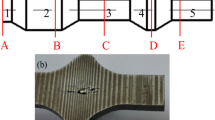Abstract
A simulation model for two-roll cross wedge rolling (CWR) was presented by using three-dimensional rigid-plastic finite element method (FEM). The whole forming process of CWR, including knifing zone, guiding zone, stretching zone, and sizing zone, was simulated using the model in which dynamic adaptive remeshing technology for tetrahedral solid elements was used to fix element distortion. Based on the simulation results, the distributions of metal flow field, strain field, and damage field, and the geometry of the workpiece’s end were analyzed. These results could provide theoretical guidance for realizing net shaping and reasonable design of tools.
Similar content being viewed by others
References
HU Zheng-huan, ZHANG Kang-sheng, WANG Bao-yu. Cross Wedge Rolling Theory and Application [M]. Beijing: Metallurgical Industry Press, 1996 (in Chinese).
HU Zheng-huan, XU Xie-he, SHA De-yuan. Skew Rolling and Cross Wedge Rolling Principles, Process and Machines [M]. Beijing, Metallurgical Industry Press, 1985 (in Chinese).
Fang G, Lei L P, Zeng P. Three-Dimensional Rigid-Plastic Finite Element Simulation for the Two-Roll Cross-Wedge Rolling Process [J]. J of Mate Proc Tech, 2002, 129(1–3): 245.
Lovell Michael R. Evaluation of Critical Interfacial Friction in Cross Wedge Rolling [J]. Transactions of the ASME, 2001, 123(2): 424.
DONG Yao-min, TAGAVI Kaveh, LOVELL Michael. Analysis of Interfacial Slip in Cross-Wedge Rolling: A Numerical and Phenomenological Investigation [J]. Journal of Materials Processing Technology, 2000, 97(1–3): 44.
LI Qiang, LOVELL Michael R. Prediction Critical Friction in a Two-Roll CWR [J]. ASME Journal of Tribology, 2003, 125 (1): 200.
DENG Zhi, LOVELL Michael, TAGAVI Kaveh. Influence of Material Properties and Forming Velocity on the Interfacial Slip Characteristics of Cross Wedge Rolling [J]. J of Manuf Sci and Eng, 2001, 123(4): 647.
DONG Yao-min, LOVELL Michael, TAGAVI Kaveh. Analysis of Interfacial Slip in Cross-Wedge Rolling: An Experimentally Verified Finite-Element Model [J]. J of Mater Proc Tech, 1998, 80–81(8): 273.
DONG Yao-min, TAGAVI Kaveh A, LOVELL Michael R, et al. Analysis of Stress in Cross Wedge Rolling With Application to Failure [J]. International Journal of Mechanical Sciences, 2000, 42(7): 1233.
Kobayashi S, Oh S, Altan T. Metal Forming and the Finite-Element Method [M]. London: Oxford University Press, 1989.
WANG Min-ting, LI Xue-tong, DU Feng-shan, et al. Hot Deformation of Austenite and Prediction of Microstructure Evolution of Cross Wedge Rolling [J]. Mater Sci and Eng, 2004, 379A(1–2): 133.
Author information
Authors and Affiliations
Corresponding author
Additional information
Foundation Item: Item Sponsored by National Natural Science Foundation of China (50705080); National Key Technology Research and Development Program of China (2007BAF02B12)
Rights and permissions
About this article
Cite this article
Wang, Mt., Li, Xt. & Du, Fs. Analysis of Metal Forming in Two-Roll Cross Wedge Rolling Process Using Finite Element Method. J. Iron Steel Res. Int. 16, 38–43 (2009). https://doi.org/10.1016/S1006-706X(09)60008-X
Revised:
Published:
Issue Date:
DOI: https://doi.org/10.1016/S1006-706X(09)60008-X



